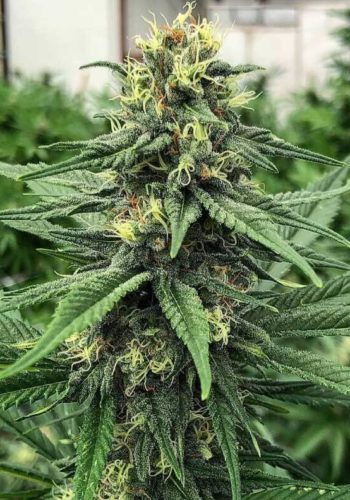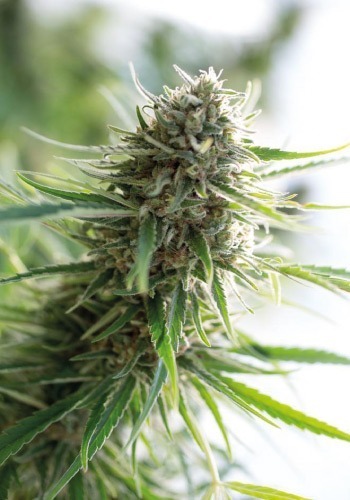CBD is a ‘non-psychoactive’ compound, which means it doesn’t make you high as THC does. Unlike THC, CBD does not directly interact with the CB-receptors in our body and brain but instead partly blocks the THC molecules from working on our CB-receptors, making us feel less high than if we only consumed THC.
Besides THC, CBD is by far the most well-known and popular cannabinoid because of its many medicinal benefits. CBD is converted from its precursor CBDA after the flower is exposed to enough UV light or heat.
The medicinal benefits of CBD
Because of the many studies done on CBD, we are reasonably certain of the benefits it has on our health, such as the ability to;
- Reduce the feeling of nausea
- Reduce and prevent epileptic seizures
- Relax our muscles
- Reduce anxiety
- Reduce inflammation
- Reduce the symptoms of psychosis (like those of schizophrenia and bipolar disorder)
- Widen our blood vessels
- Reduce muscle spasms
- Make sure our body tissues get enough oxygen
- Protect us from harmful bacteria
- Reduce the symptoms of the skin disease Psoriasis
- Reduce the sensation of pain
- Reduce the feeling of hunger
- Stimulate bone growth and help heal bones faster
- Help strengthen our immune system
- Help protect our body’s cells from damage
- Help to reduce the growth of cancer cells
Is the use of CBD safe?
Through the many studies done on CBD, we now know that even long-term consumption and high doses of up to 1500 mg per day will give us no negative side-effects.
CBD and the entourage effect
CBD works even better if we combine it with other cannabinoids and terpenes. This boost in efficiency is called the “Entourage Effect” (EE). The EE of CBD is especially effective in combination with the terpenes limonene, linalool, pinene and caryophyllene, by making it more easily absorbed by our bodies.
The scientific research on CBD
CBD (Cannabidiol) is a non-psychoactive phytocannabinoid with multiple medical properties, representing one of the most common cannabinoids in hemp plants and second most prevalent in certain cannabis chemotypes. From a chemical point-of-view, it is structurally similar to THC, and is produced from an acid precursor (CBD-acid or CBDA) through a reaction promoted by heat (decarboxylation).
CBD levels in the cannabis plant
Its content percentage in any given plant is variable, depending on the heating method and the strain: generally balanced/high CBD strains may contain 5 to 20% of CBD and oil-based products generally contain higher levels of both CBD and CBDA than the non-oil products.
The science behind the Cannabidiol
Unlike THC, CBD shows low binding affinity (1) with CB1- and CB2- receptors of the endocannabinoid system (ECS), acting as a “non-competitive antagonist” (2) by binding to these receptors, thus preventing their activation by endocannabinoids. The “unusual” characteristic of CBD is that, in the presence of THC, this compound performs this action even at low concentrations; moreover, this cannabinoid can modulate the adverse effects associated with THC such as anxiety, an abnormally rapid heart rate, hunger, and sedation.
From a pharmacological point of view, CBD has proven to be extremely versatile with a high potential for therapeutic use, including:
- Anti-epileptic (3)
- Anxiolytic (4)
- Anti-psychotic,
- Vasorelaxant (5)
- Antispasmodic
- Anti-ischemic (6)
- Antiproliferative (7)
- Antibacterial
- Antipsoriatic (8)
- Analgesic
- Bone growth-stimulant
- Immunosuppressive
- Neuroprotective effects
At high doses it could also be used as treatment of a variety of conditions ranging in addictions, psychiatric disorders to diabetes and nausea. At lower doses its antioxidant (of note, CBD has shown to be more effective than vitamin C and E as a neuroprotective antioxidant), anti-inflammatory, and neuroprotective action promotes and maintains health.
Why is CBD save?
With regards to the safety profile, CBD’s consumption doesn’t induce catalepsy (9) and doesn’t adversely affect physiological (heart rate, blood pressure and body temperature), psychological and psychomotor functions. Long-term consumption and high doses of up to 1500 mg per day have shown to be well tolerated and show no signs of adverse side-effects.
How does Cannabidiol effects with other cannabinoids?
CBD’s pharmacological activity is the result of a co-action (entourage effect) with substances known as terpenes. CBD decreases the psychoactivity and other side effects of THC, while enhancing its benefits; the terpenes limonene, linalool, pinene and caryophyllene enhance its effects and make it more efficient and more easily absorbed by our bodies.


